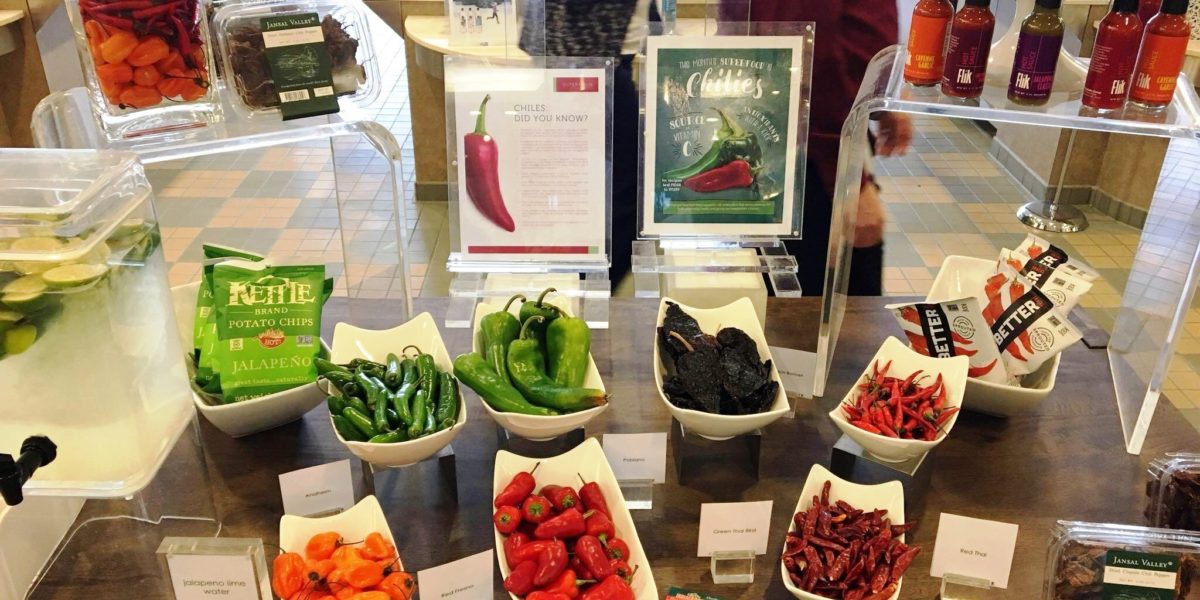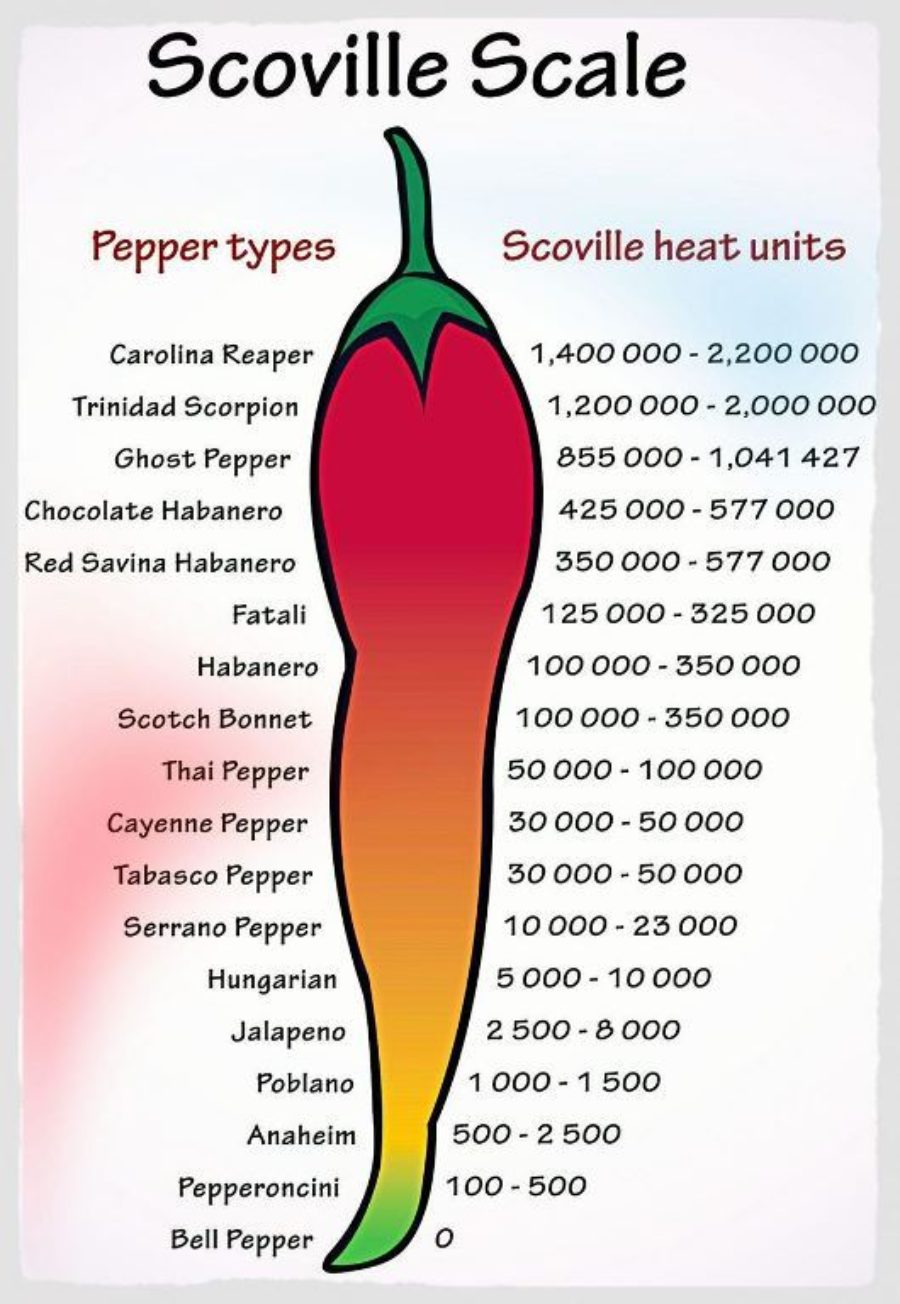
5 Chili Peppers to Turn Up the Heat
Whether you’re a spice friend or foe, you are bound to find a chili pepper that’s right for you. Not all peppers are created equal and some aren’t spicy at all. In fact, these fruits (we know, you probably thought they were veggies!) vary in spiciness so much that an official scale, known as the Scoville Heat Units (SHU), was created to rank their spiciness. So what causes some peppers to top the charts and others to be cool as a cucumber? That would be capsaicin, the compound in chili peppers that is responsible for spiciness. Pure capsaicin is equivalent to about 16,000,000 SHUs, while a bell pepper has 0 SHUs.

Capsaicin does more than provide chilis with their spicy flavor – it is also associated with several health benefits. Capsaicin may boost your metabolism to aid with weight loss and might serve as a pain reliever. Capsaicin has been shown to signal the body to release certain neurotransmitters and something called “substance P” which is involved with pain signaling. Don’t go overboard though, as ample amounts of capsaicin are so powerful that it has been developed into a self-defense tool (hint: pepper spray)! While capsaicin may have its benefits, this does not mean peppers sans spice, or with low capsaicin content, lack flavor and health benefits – they just taste different. In general, chili peppers contain vitamin A, vitamin C and potassium, as well as small amounts of iron and magnesium; the exact amount and special nutrient properties vary by the type (and color) of the pepper.
Intrigued? Keep reading to learn about five unique chili varieties that will add more than just a kick to your meals.
SHISHITO (50-200 SHU)
You may have noticed Shishito peppers popping up more and more on restaurant menus, and it’s because they are delicious! Due to their increase in popularity, you’re now likely to find them in certain mainstream grocery stores. Buyer beware… the reason this pepper has a range in SHUs is because one out of every fifteen typically contain some spice; think Russian roulette of chilis. Shishitos can be easily sautéed with garlic and sesame oil to create an easy side dish, or they’re excellent when chopped and used as a pizza topping.
TABASCO (30,000 - 60,000 SHU)
An oldie, but goodie – it’s worth diving into the pepper that’s the base for one of America’s favorite condiments: TABASCO® hot sauce. Hopefully the SHUs for this classic seasoning provides some perspective on how mild or hot some of the other peppers are; however, it’s worth mentioning that the raw pepper is 12x as spicy as the sauce it’s used to make. The Tabasco chili is super versatile and is grown throughout the world due to its widespread use in a variety of cuisines. It needs plenty of sun, so if you’re planning to grow your own, make sure you plant your seeds in an unshaded area. Enjoy this chili at breakfast on eggs or pickled with its longtime companions, salt and vinegar, to mimic the flavor of the original fan-favorite sauce.

SCOTCH BONNET (100,000-325,000 SHU)
The Scotch Bonnet’s original name comes from its resemblance to a bonnet hat, but it also holds several other cute nicknames, such as the Bonney Pepper and Bahama Mama. The chili is popular in African and Caribbean cuisine and often confused with a habanero. While you are unlikely to find these peppers at a local supermarket, they can usually be found in specialty and ethnic stores. Like the Carolina Reaper, the Scotch Bonnet chili is very spicy, and tastes delicious when added to fruity marinades and jams, or as a star ingredient in jerk seasoning. They are also a very popular choice for boutique hot sauces. Tip: if you want to lessen the heat of this pepper, remove the seeds and inner tissue and stick to using the outside part of fruit.
BHUT JOLOKIA (1,000,000 SHU)
Can you say the name of this pepper five times fast? It’s okay, neither can we. The Bhut Jolokia, also known as the ghost pepper, used to be the spiciest pepper in the Guinness Book of World Records, until it was mixed with a habanero pepper to create the twice-as-spicy Carolina Reaper. This chili is often used in Indian cuisine, and the spiciness usually sneaks in around 30-45 seconds AFTER you eat it (hence the nickname “ghost pepper,” surprise!). If you’re cooking with this pepper, take caution and use gloves to avoid burning your skin. It is usually reddish in color, which studies show is associated with the presence of lycopene– a phytonutrient which may offer antioxidant, anti-cancer and cardiovascular health benefits.
CAROLINA REAPER (2,000,000 SHU)
If you don’t love spicy, beware, because this is the hottest pepper of all peppers. The Carolina Reaper is a man-made chili that resulted from crossing a red habanero with what was historically the spiciest pepper – the ghost pepper. Though it contains the most SHUs of any pepper, this chili also has some fruity aspects and pairs well when mixed in citrus marinades for poultry and other meats. If you’re working with the dried version, try sprinkling a bit over some homemade mac & cheese or add sparingly to chocolate sauces and frostings for an extra kick.
+++
What We Were Talking About in 2018: MIT Stories: Meet Christina
At FLIK Hospitality Group we believe in great food, great service, and great people. Our wellness first approach ensures our food supports healthy and delicious choices, specially curated by our team of culinary experts and registered dietitians. At FLIK, we believe in seasonality in sourcing our ingredients and providing a customized approach to the culinary and hospitality needs of each client. Our dedication to providing quality hospitality service is unparalleled in the industry.
Have feedback or questions for our team? Email us at flikblog@compass-usa.com.
Interested in working with us? Apply today!